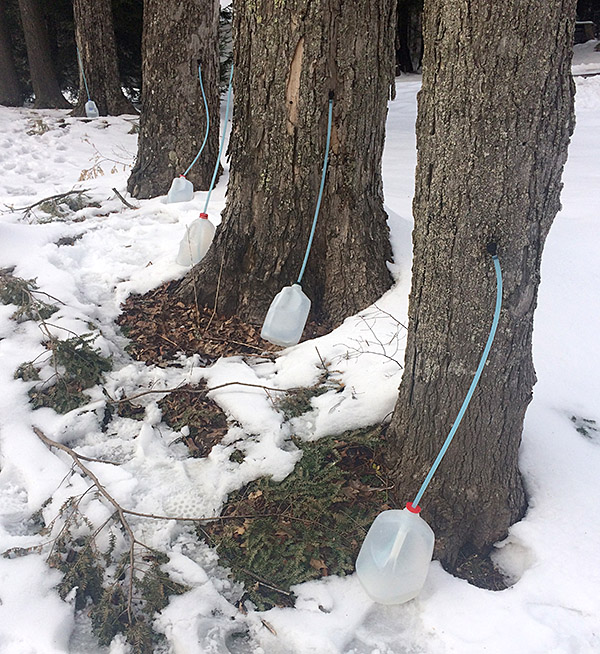
It’s maple syrup time again. The days are getting longer. For sap to flow, the days need to be above freezing (and ideally, sunny) and the nights below freezing. This has been a mild winter, overall, so President’s Day weekend was a good time to put out the taps.
We had the spiles and tubes all ready and by the door. We had been saving (or scrounging) one-gallon water jugs. I had the drill bit and rubber mallet set aside. So, when the day came, we were ready.
The trees along the road are sugar maple (Acer saccharum) and usually produce well because they get some afternoon sun. The maples out along the stream (now a beaver pond) are red maple (Acer rubrum) which don’t usually produce much sap. They don’t get much sun.
Eyeing Sugar Content
Sugar maples usually have a sugar content of around 2%. That’s why it takes so much boiling down of the sap to get syrup. You need to boil off 90-something percent of the water. Red maples usually have around 1% sugar content. That means that you would have to start with twice as many gallons of raw sap to boil down to the same amount of syrup.
Sugar content tends to run a little higher in the earlier part of the season. The first sap from the trees along the road read at 4%. For that reason, we still tap some red maples down along the stream. Later in the “season,” we won’t worry about them much.
Fortunately, the trees along the road produce well so we’re not trying to rely on the weaker-sap red maples.
For a review of the “how to” of the syrup boiling process, refer to last year’s post.
Better Burns
New this year is a better propane burner. Our original burner (made for outdoor fish fries) was not especially efficient. On “high” (enough to boil sap), it made lots of yellow flames. The inefficiency produced a ton of soot. This soot would coat the bottom of the pot, eventually acting as an insulator — further reducing efficiency.
This year, we got a new propane grill for the deck. The old one had too many leaks. The new grill has a burner on the side. It has a very efficient burner. After several boils, it has produced zero soot on the pots. Where it took four hours (or more) to boil down two gallons of sap, it now takes three and a half. All this means we’ll go through less propane AND have none of the black mess. Soot particles are so fine that they stain anything even slightly porous.
Grid-down Syrup?
The sap flows from the trees without any power. Drilling the holes for the taps could be done with my brace and bit or my egg-beater style drill. I could still use my cordless drill (faster, straighter) since I can recharge that from my solar panels.
It is the boiling that would have to adapt. Right now, we enjoy the ease of using propane to boil down our sap. If we could not get propane, we have the cinderblocks and steel grate to make an outdoor rocket stove. If we knew we were going to have to boil over a wood fire, we would be scavenging the woods for deadfall (there’s usually plenty of that) to save and dry out. We would have a pile of such branches for our fuel.
Wood-fired sap boiling would take more attention but would still yield a natural sweetener harvested off of the homestead. Given that many people in the town tap their trees too, our syrup would not be a rare or coveted commodity. Rather, it would simply be another step in food independence.
We could, of course, buy gallons of Mrs.Butterworths from Walmart with what we spend on propane. We also know exactly what’s in our syrup — maple sugar: not corn syrup, colorings, etc. etc. But, financial frugality was not the goal. Practicing food independence is the goal.
—-
